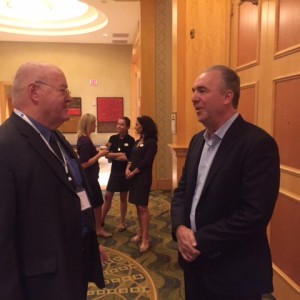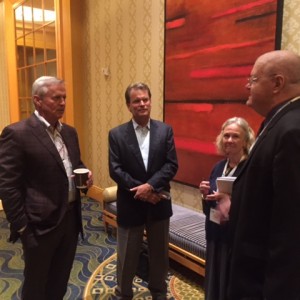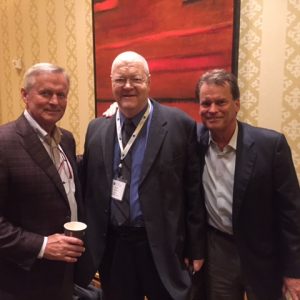The picture in the following article contains a number of people who were part of the outstanding team who performed the MRI Focused Ultrasound procedure on me:
Charlene Aldrich – who was beside me the entire time except when the sonications were happening; Dr. Howard Eisenberg – the neurosurgeon; Dr. Paul Fishman – the neurologist; Dr. Deeraj Gandhi – the radiologist; Pam Janocha; Erma Owens; Mor Dayan – Insightec (not pictured)
There were others. As a result of the Ativan and many things occurring simultaneously, I was not aware of them.
Everybody acted professionally and as a team!
— Peter
In recognition of their leadership in advancing focused ultrasound research for the brain, the Foundation is pleased to designate the University of Maryland as a Center of Excellence.
|
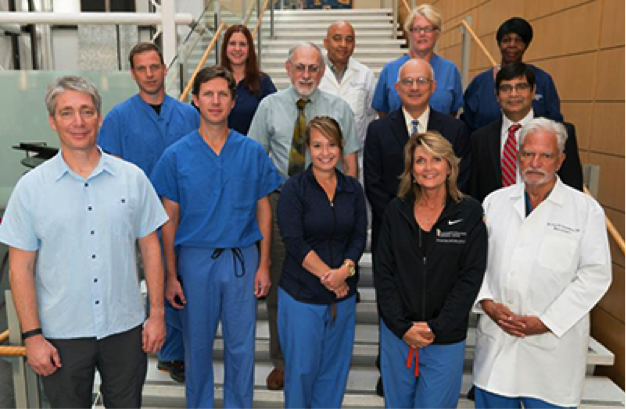 |
|
Maryland’s “Brain Trust”
(R to L) Front: Dr. Victor Frenkel, Dr. Graeme Woodworth, Kaitlyn Henry,
Charlene Aldrich, Dr. Howard Eisenberg Middle: Andy Hebel, Dr. Paul Fishman,
Dr. Elias Melhem, Dr. Deeraj Gandhi Back: Liz Rolon, Dr. Rao Gullapalli, Pam Janocha,
Erma Owens |
The Chair of the Department of Neurosurgery, Howard Eisenberg, MD, and Chair of Diagnostic Radiology and Nuclear Medicine, Elias Melhem, MD, are managing a comprehensive bench-to-bedside program expanding the technology’s neurosurgical capabilities as well as innovating new methods for delivering therapies to the brain.
“The University of Maryland has created a dream team of experts in neurosurgery, neuroradiology, neurology, and biophysics that is collaborating to establish new frontiers to optimize the technology to treat a range of neurologic and psychiatric disorders,” says Foundation Chairman Neal F. Kassell, MD.
Both Eisenberg and Melham have a long-standing interest in focused ultrasound (FUS). Dr. Eisenberg had served as a consultant to the Foundation for over a decade. Dr. Melhem initially became aware of FUS when he was at the University of Pennsylvania and heard Ferenc Jolesz give a talk about 10 years ago. “This really captured my imagination for the potential of the technology,” says Melhem. He was not able to obtain a system at Penn, but as he was being recruited to be Chairman of the Radiology Department at Maryland in 2012, he solicited support from the Dean of the School of Medicine to invest in creating a hub for focused ultrasound research. Since then he has invested in an Insightec Exablate clinical platform and basic science systems. The Departments of Radiology, Neurology and Neurosurgery have collaborated to create a multidisciplinary team of experts that has attracted more than $500,000 in research grants to date and laid a pipeline for future funding.
Clinical Program
Maryland has been a top site for recruiting patients into essential tremor (ET) and Parkinson’s disease clinical trials through the leadership of Drs. Melhem and Eisenberg, along with neurologist Paul Fishman, MD, PhD, and research coordinator Charlene Aldrich, who is credited for being an extremely effective ambassador to the patient community. The FUS clinical center at Maryland is conveniently located within the hospital with a new dedicated MRI scanner, its own prep area, waiting room, and recovery area.
“It is very fulfilling to be able to provide a less invasive option for patients – some just don’t want an electrode put into their brain,” says Dr. Eisenberg. With his neurophysiologic training, Dr. Fishman is a valuable member of the treatment team. He assesses patients and collaborates on the brain mapping before procedures, evaluates patients with each sonication, and afterwards conducts the follow-up visits.
Now that the Exablate system is approved to treat ET, the team looks forward to treating patients commercially. “We want to collaborate with other sites so we know where patients from certain regions of the country should go for treatment,” says Eisenberg.
Optimizing Clinical Treatment
The team is also looking forward to pushing the boundaries of ablation for movement disorders. “Now that we have established a foothold for unilateral ET, we want to expand the beachhead to explore treating the second side and retreating patients who may lose the effect,” says Fishman. “These questions are even more vital for Parkinson’s because the disease is commonly bilateral and more progressive.” See his July 2016 Foundation Webinar on Research Progress in Parkinson’s Disease and a Role For Focused Ultrasound.
There is agreement that a global registry is needed so sites can utilize common protocols and share insights into issues such as what types and symptoms of Parkinson’s are best served by ablating certain targets. “That is where the clinical research is heading, and it is very exciting to be on the leading edge of making these determinations,” says Fishman.
Breaking Through Barriers to the Brain
Maryland has a consolidated scientific research facility with two MRI scanners, a preclinical FUS system from Image Guided Therapy, a benchtop custom built animal system, and many ultrasound-based resources. They have seven faculty members involved from radiology, immunology, ultrasound biophysics, cancer biology, chemical and mechanical engineering, and neurosurgery.
Dr. Fishman is a bridge to the scientific team at Maryland. After decades in the lab developing experimental agents for neurodegenerative disorders, he collaborated with neurosurgeon and scientist Graeme Woodworth, MD, FUS biophysicist Victor Frenkel, PhD, and others to optimize the use of focused ultrasound to breach the blood-brain barrier (BBB) and deliver these types of therapies.
The team is making preclinical progress on drug delivery to the brain along several fronts. They are opening the BBB with FUS and utilizing magnets to direct magnetically labeled stem cells to targeted areas in the brain. Dr. Woodworth is working with the FDA to get clearance for a clinical study that would use FUS to open the BBB to deliver a dye to improve visualization within a brain tumor and to determine how deep small molecules can penetrate the brain.
“FUS could become the first clinically versatile way of introducing this enormous backlog of therapeutics that do not cross the blood-brain-barrier,” says Fishman. “If it works, this could alter the scientific and clinical landscape for treating the brain.”
Dr. Frenkel, from the department of Radiology, has created a custom portable system for studying FUS-mediated neuromodulation and is assessing how altering the microenvironment of the brain affects the inflammatory response and the movement of nanoparticles through neurological tissue. “There is a possibility that we can alter the natural history of some pretty devastating diseases,” says Woodworth. “We are just a year or two away from clinical trials.”
A Promising Future
The leadership is very optimistic about the potential for the technology and the impact of being a Center of Excellence. “This recognition will help to drive awareness across other departments that will open up doors for new collaborations leading to more novel ideas and better solutions to pursue,” says Eisenberg.
“Our achievements in focused ultrasound – both in terms of advancing the science and transforming clinical care – have been recognized by the Dean and our Board of Trustees,” says Melhem. “We are looking forward to continuing to demonstrate that we are a model for excellence in the field.”
Recently Published Work from the Maryland Team
Elias WJ, Lipsman N, Ondo WG, Ghanouni P, Kim YG, Lee W, et al. A Randomized Trial of Focused Ultrasound Thalamotomy for Essential Tremor. N Engl J Med 2016 Aug 25;375(8):730-9.
Hersh DS, Kim AJ, Winkles JA, Eisenberg HM, Woodworth GF, Frenkel V. Emerging Applications of Therapeutic Ultrasound in Neuro-oncology: Moving Beyond Tumor Ablation.Neurosurgery 2016 Aug 22.
Khanna N, Gandhi D, Steven A, Frenkel V, Melhem ER. Intracranial Applications of MR Imaging-Guided Focused Ultrasound. AJNR Am J Neuroradiol. 2016 Aug 18.
Hersh DS, Nguyen BA, Dancy JG, Adapa AR, Winkles JA, Woodworth GF, Kim AJ, Frenkel V. Pulsed ultrasound expands the extracellular and perivascular spaces of the brain.Brain Res. 2016 Sep 1;1646:543-50. doi: 10.1016/j.brainres.2016.06.040. Epub 2016 Jun 28.
Hersh DS, Wadajkar AS, Roberts NB, Perez JG, Connolly NP, Frenkel V, Winkles JA, Woodworth GF, Kim AJ. Evolving Drug Delivery Strategies to Overcome the Blood Brain Barrier. Curr Pharm Des. 2016;22(9):1177-93.
Tebebi PA, Burks SR, Kim SJ, et al. Cyclooxygenase-2 or tumor necrosis factor-alpha inhibitors attenuate the mechanotransductive effects of pulsed focused ultrasound to suppress mesenchymal stromal cell homing to healthy and dystrophic muscle.Stem Cells (Dayton, Ohio). Apr 2015;33(4):1173-1186.
Ziadloo A, Xie J, Frenkel V. Pulsed focused ultrasound exposures enhance locally administered gene therapy in a murine solid tumor model.J Acoust Soc Am Mar 2013;133(3):1827-1834.

 In the early 1990s, a number of companies started to offer software that was designed to convert spoken words into text that could then be displayed or printed. Among the early commercial offerings was a program entitled “Dragon Naturally Speaking”. In 1994, I tried an early version of Dragon in my workplace. After installing a microphone to my computer, I spoke several sentences rather slowly, and watched words appear on the computer monitor. Unfortunately, there were quite a few errors in the written text, and I chose to stick with keyboard entry.
In the early 1990s, a number of companies started to offer software that was designed to convert spoken words into text that could then be displayed or printed. Among the early commercial offerings was a program entitled “Dragon Naturally Speaking”. In 1994, I tried an early version of Dragon in my workplace. After installing a microphone to my computer, I spoke several sentences rather slowly, and watched words appear on the computer monitor. Unfortunately, there were quite a few errors in the written text, and I chose to stick with keyboard entry.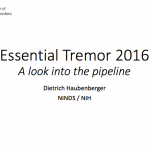 When we founded HopeNET 5 years ago, we felt that the thing that the ET community needed most at that time was HOPE – hence the name. In the meantime, we have strived hard to bring some hope to all with ET. Accordingly, HopeNET played a key role in having the ET conference at NIH in May 2015. Since that conference, there has been a big increase on the part of industry in developing new treatments for ET. Dr. Dietrich Haubenberger of NIH is probably in the best position to know what is going on with ET. He came to the Falls Church, Virginia ET support group on October 14th and made the attached presentation,
When we founded HopeNET 5 years ago, we felt that the thing that the ET community needed most at that time was HOPE – hence the name. In the meantime, we have strived hard to bring some hope to all with ET. Accordingly, HopeNET played a key role in having the ET conference at NIH in May 2015. Since that conference, there has been a big increase on the part of industry in developing new treatments for ET. Dr. Dietrich Haubenberger of NIH is probably in the best position to know what is going on with ET. He came to the Falls Church, Virginia ET support group on October 14th and made the attached presentation, 
